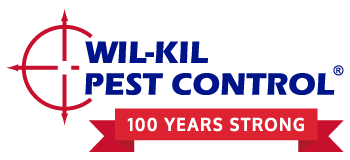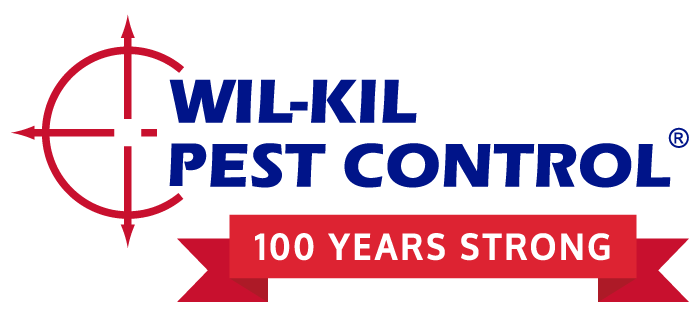Ashley Patzer, Marketing and Sales Associate
Get A Free Quote
As someone new to the world of pest control, with a life-long case of Arachnophobia, I didn’t know what to expect on my day in the field with a Wil-Kil Pest Control technician. Like most people, I assumed that pest control technicians simply arrived at an infested building, doused the area with a cocktail of chemicals, and left the scene. I was wrong.
How do pest control technicians begin their day?
When I arrived at our first stop, I met Travis, the technician I would be shadowing for the day. Travis was very friendly and happy to see that I brought a rain jacket. Every location we visited that day required both interior and exterior treatment and/or evaluation. A factor I hadn’t considered in pest control is the weather. Unpredictable Wisconsin weather means a technician needs to be ready to adjust their day’s strategy on a moment’s notice.
Our morning began by checking in with the property’s contact. One of the biggest pieces of Integrated Pest Management (IPM) is communication. By checking in beforehand, he could ask if they’ve noticed any increased pest activity on the property that they want him to be aware of. After the clients notified him of their concerns, off we went.
So, what do pest control technicians do?
Our first stop at each location was checking the exterior bait stations around the perimeter of the building for rodent feeding activity. Unlike traps that catch rodents, bait stations are locked boxes that contain rodenticides which will eliminate any rat or mouse that snacks on it within a few days. If the bait stations showed signs of snacking, the technician documented the activity and restocked the station with fresh product. By replacing the product, he’s able to detect if there has been additional activity on his next scheduled service.
Once we completed checking and restocking the bait stations on the perimeter of the buildings, we headed inside to evaluate and treat the interiors. The main difference between exterior and interior treatment is the materials and traps our technicians use. While bait stations are effective outside, products like glue boards, mechanical traps, and insect light traps are best utilized indoors.
Glue boards are sticky strips of plastic that catch a wide variety of pests including flies, roaches, and spiders. These are generally placed inside insect light traps, mechanical traps, and independently on low surfaces. Insect light traps come in a variety of styles to kill flying insects. Some are disguised as decorative sconces, while others are vertical wall-mounted devices. Decorative models are commonly used in foodservice locations to blend in with their surroundings. And, finally, classic mechanical traps are used to catch and eliminate rodents.
One item that I found particularly interesting about the commercial properties we visited was the attention to detail in their layout and construction. Every facility required a barrier between the exterior walls and the stored products. This barrier made it relatively easy for me and Travis to evaluate the perimeter of the interior walls. Although I will warn you – if you are claustrophobic or afraid of the dark, pest control might not be in your cards.
In addition to checking and emptying the interior traps, technicians check for areas in the facility that may be opening the door, sometimes quite literally, for insect and rodent activity. This preventative measure has the potential to save a company from audit deductions or even audit failures due to pest activity.
The areas that we paid special attention to were shelving in food storage closets and exterior entry points. When food isn’t properly stored and doors leading to the outside are left propped open, you could be encouraging insect or rodent activity.
What do pest control technicians wear?
Every facility requires that some level of Personal Protective Equipment (PPE) be worn. The food packaging facility we serviced that day required the most amount of PPE: earplugs, reflective safety vest, safety glasses, and steel-toed boots. I asked Travis if it’s hard to remember what is required to wear at each location. He said it quickly becomes second-nature, but for someone like me who is not accustomed to wearing PPE every day, often facilities have spare safety equipment they are happy to lend you.
How many pests did you run into?
My biggest fear prior to shadowing a pest control technician was the number of bugs and mice I would encounter – particularly spiders. While we certainly saw a handful of trapped mice and insects, not once did I catch myself running away from any pests. We encountered a limited number of pests because our technicians take strategic, preventative measures to ensure that pests are taken care of before they become a problem.
Do pest control technicians get lost in large buildings?
Most of the locations we visited had multiple buildings and levels. It amazed me how Travis was able to remember where traps were located on the large commercial properties he services. He said that it becomes routine the more he services a location. However, if he does forget to check an area, his portable digital assistant (PDA) will remind him which traps or bait stations were missed in the service.
A New Perspective
Once he completed each property’s service, we returned to his point of contact to inform them of any new or worsening activity. This was also the time for him to give recommendations to prevent future problems. It was cool to see how much each client appreciated the personalized care they received before and after each service.
Even though I was hesitant to spend a day in the field with a pest control technician, I am grateful to have had the first-hand experience. After learning about the critical impact that pest control has on our health and safety, I’m excited to be a part of such an integral industry with an organization like Wil-Kil Pest Control.


